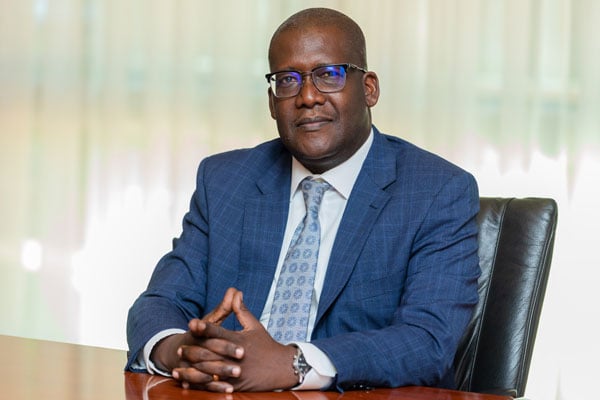How big is Africa’s middle class?

A restaurant like this will survive on the presumption that the working class, which makes up much of the middle class, will make its biggest clientele. Photo by Rachel Mabala.
What you need to know:
Reports show conflicting figures of the African middle class with some saying it is 18 million people while others put it at 300 million. Jonathan Adengo looks at the different reports to give us a picture of the size of Africa’s middle class.
The numbers are in and indeed they confirm a long held speculation – Africa is sliding and at an awfully terrible speed.
In 2011, to be exact four years ago, the African Development Bank (AfDB) estimated more than 300 million Africans to be in the middle class but current statistics tell a different story.
Perhaps the numbers could have been exaggerated, if not something terrible has happened.
It would be ironical that a report released last month by Credit Suisse puts Africa’s middle class at a dismal 3.3 per cent, which translates into about 18.3 million people.
Africa is home to an estimated 1.166 billion people spread in at least 54 sovereign states.
The continent’s middle class, analysts argue, is on the cusp of slipping into poverty given that it is held down by multitudes of dependents.
In another report authored by the Pew Research Centre, estimates show that only about 6 per cent of Africans could be earning between $10 and $20 per day but much of it goes to dependents.
Africa’s middle class, estimates show, controls more than 30 per cent of the continent’s wealth, which could explain the high degree of dependence.
But Credit Suisse, a Swiss-based research and wealth measurement firm puts it at a much lower figure, highlighting in its Global Wealth Databook 2015 that the continent could currently be a “pain point” for investors.
This, the report says, is supported by the failure of Africa’s assumed middle class to support multinationals that had thought they would leverage on the continent’s growing wealthy club.
Therein lies the deep analogue that could explain why companies on the continent tend to downsize even after making pompous entries in the continent’s markets.
Amid all this, multinationals, such as Nestlé and Coca-Cola, Airtel, Orange Telecom, among others, have scaled down operations as they seek to cut losses after failing to achieve intended targets.
The downsizing and organisational scaling has also waved through indigenous Africans firms, making many to lose jobs at a time when the future is looking bleaker.
Recently, Whitey Basson, the Shoprite Holdings Group chief executive officer was quoted as saying it had become increasingly difficult to compete informal traders.
This, he said, had forced them to quit some markets including, Tanzania because: “We just couldn’t compete with the informal trade. It’s just a waste of time for us to expand in a market where we can’t get the optimum size for having enough stores to make a meaningful contribution to us.”
Shoprite, just like other retail businesses such as Kenyan – based Uchumi Supermarkets has suffered revenue knock-ons resulting from heavy currency depreciations and general economic weaknesses across sub-Saharan Africa.
But amid all this the key question could be: was the rise of the African middle class an exaggerated fallacy as it is progressively being claimed?
By 2000, data shows, Africa had 17.5 million middle class citizens; however, the number has grown dismally to an estimated 18.3 million, which means that only 800,000 people have been added over 15 years.
However, in the same period, China has added 43.3 million people to its middle class compared to India is 7.7 million.
But this could be a result of reducing numbers given that between 2007 and 2008 Africa shed 7.5 million of its middle class.
The two years of 2007 and 2008 were the brunt of the global financial crisis, which squeezed the middle class into debt and some could have failed to recover.
But this has been worsened by economic volatilities that recently forced the International Monetary Fund in its new outlook report to agree that sub-Saharan Africa was declining and would impact growth.
Thus, IMF, said it would further cut sub-Saharan Africa growth projections to 3.75 per cent from the earlier 4.5 per cent.
And for this, Aly Khan Satchu, a Nairobi-based equity markets analyst says “therein lies the conundrum, because the AfDB could have had a very low threshold,” against which it measures the middle class.
However, he believes that for someone on the African continent to earn a monthly income of at least $1,000 (Shs3.6m) or possess a net asset of about $10,000 (Shs36.6m), qualifies to be a middle income citizen.
The Credit Suisse report uses an asset based formula to calculate wealth unlike AfDB, which uses incomes to measure wealth.
Thus, notwithstanding AfDB’s agenda, Satchu says there should be realistic formula against which wealth is measured instead of “sugar-coating”.
However, Jeremiah Mutonga, AfDB Uganda country representative, argues that measuring wealth should be relative and put into context to a particular country.
For instance, he says that whereas someone in Uganda who can afford a second hand car of about Shs15m will be considered as a middle class citizen, in another country such as Switzerland that person is considered poor.
Therefore, as he argues, “there is no slowdown of the middle class but rather the sharp difference in figures is grounded in the difference in defining the middle class”.
But the biggest irony is that some 4.3 million of the continent’s middle class live in just one country, South Africa, but the number raises to 14.1 million if other countries such as Algeria, Egypt, Tunisia, Morocco and Nigeria are thrown on the pack.
This means that the reminder of the middle class, which is about 4.7 million are shared between more or about 48 countries on the entire continent.
The Credit Suisse report captures Uganda as a lower income country with an estimated average income of $674 (Shs2.4m) per adult.
The country has registered some growth from its $332 (Shs1.2m), which its adult people earned per annum in 2000.
View from an expert
The size of the middle class in an economy and at the level of the African continent, according to Mutonga, matters a lot because it helps to direct the country in terms of governance, where by the middle class, for self-interest, demands good governance and accountability from those in power but beyond that it can also demand for quality goods and services.




